Operation Featherlite: Difference between revisions
m Text replacement - "Category:2023 Award winning pages" to "{{Template:Award winning article}} Category:2023 Award winning pages" |
|||
| (11 intermediate revisions by 2 users not shown) | |||
| Line 6: | Line 6: | ||
| image_size = | | image_size = | ||
| alt = | | alt = | ||
| caption = | | caption = (Clockwise from top left) Arcer warships off the coast of Gramsby; 1 Rifle Brigade lands on Swindon; Am Arco cargo aircraft drops supplies at Larton for ground forces; Infantrymen from the Royal Easthampton Borderers pause during the Long March at Larton. | ||
| date = 7 October - 19 November 1986 | | date = 7 October - 19 November 1986 | ||
| place = [[Foxhey Governorate]], [[Arcerion]], [[Crona]] | | place = [[Foxhey Governorate]], [[Arcerion]], [[Crona]] | ||
| Line 38: | Line 38: | ||
| campaignbox = | | campaignbox = | ||
}} | }} | ||
'''Operation Featherlite''' was the military landing of [[Arcerion|Arcer]] troops supported by aircraft and naval vessels on the islands of [[Foxhey Governorate]], in an effort to retake the strategically important [[Gibson Gap]]. | '''Operation Featherlite''' was the military landing of [[Arcerion|Arcer]] troops supported by aircraft and naval vessels on the islands of [[Foxhey Governorate]], in an effort to retake the strategically important [[Gibson Gap]]. It saw combat on land, sea, and air, as Arcer troops landed on the islands of Swindon, Gramsby, Larton, and Sharnwick under adverse weather conditions and worked to retake them from Kelekonan control. Ultimately Kelekona would surrender, effectively ending their attempts to gain the islands and they remained part of sovereign Arcerion. | ||
== Background and Preparation == | == Background and Preparation == | ||
The [[Arcer General Staff]] had undergone preparations to retake the islands in the [[Gibson Gap]]. The movement of three brigades, notably 7 Rifle Brigade, with its mountaineering and cold weather experience, and a large contingent from the [[Arcerion Parachute Regiment]] as part of 11 Parachute Brigade. Arriving in [[Craigfearn]], they quickly began coordinating plans for landings and recapture of the islands, beginning first with coordinating efforts with the [[Arcer Air Force]] and [[Royal Arcerion Naval Service]]. | The [[Arcer General Staff]] had undergone preparations to retake the islands in the [[Gibson Gap]]. The movement of three brigades, notably 7 Rifle Brigade, with its mountaineering and cold weather experience, and a large contingent from the [[Arcerion Parachute Regiment]] as part of 11 Parachute Brigade. Arriving in [[Craigfearn]], they quickly began coordinating plans for landings and recapture of the islands, beginning first with coordinating efforts with the [[Arcer Air Force]] and [[Royal Arcerion Naval Service]]. | ||
| Line 48: | Line 48: | ||
The [[Royal Arcerion Submarine Service]] during this time had its new ''Dolphin''-class diesel electric attack submarines shadow the Kelekonese Navy, and had been conducting attacks on supply ships and other vessels bringing commerce into the Northern Malentine Sea. Sorties from [[Chester-on-Moore]] were constant and proved to be effective, as the Navy's blockade of the Warrington Strait prevented new ships from entering the Malentine Sea. | The [[Royal Arcerion Submarine Service]] during this time had its new ''Dolphin''-class diesel electric attack submarines shadow the Kelekonese Navy, and had been conducting attacks on supply ships and other vessels bringing commerce into the Northern Malentine Sea. Sorties from [[Chester-on-Moore]] were constant and proved to be effective, as the Navy's blockade of the Warrington Strait prevented new ships from entering the Malentine Sea. | ||
[[File:Shot down Kelekona aircraft.jpg|thumb|Gun camera footage from a ''Goshawk'' fighter aircraft of No.19 Squadron, Arcer Air Force shows a Kelekonan fighter being shot down over Larton Island. ]] | [[File:Shot down Kelekona aircraft.jpg|thumb|Gun camera footage from a ''Goshawk'' fighter aircraft of No.19 Squadron, Arcer Air Force shows a Kelekonan fighter being shot down over Larton Island. ]] | ||
Preparations focused on the landings, and a Task Force (Task Force 86) was organized around the Arcer aircraft carrier, the ACS ''Kurst'' and placed under the command of Vice Admiral Lawrence Thistle, who would work closely with the land contingent commander, Lieutenant General Stephen van der Berg. Plans were for a short but aggressive air campaign, followed by landings in Farnsworth, followed by Swindon and Gramsby. During the preparations for the operation, a surprise attack by several Kelekonan destroyers and frigates on [[Port Gibson]] damaged much of the runway and support facilities. With the main military airfield in Foxhey damaged, the Arcer Air Force was forced to sortie out of Dunborough, Craigfearn, and Kinnaird. The extended times would only be cut down once the smaller runway at Farnsworth could be repaired, and with some sorties being conducted by the Naval Air Arm from the ''Kurst''. | Preparations focused on the landings, and a Task Force (Task Force 86) was organized around the Arcer aircraft carrier, the ACS ''Kurst'' and placed under the command of Vice Admiral Lawrence Thistle, who would work closely with the land contingent commander, Lieutenant General Stephen van der Berg. Plans were for a short but aggressive air campaign, followed by landings in Farnsworth, followed by Swindon and Gramsby. During the preparations for the operation, a surprise attack by several Kelekonan destroyers and frigates on [[Port Gibson]] damaged much of the runway and support facilities. With the main military airfield in Foxhey damaged, the Arcer Air Force was forced to sortie out of Dunborough, Craigfearn, and Kinnaird. The extended times would only be cut down once the smaller runway at Farnsworth could be repaired, and with some sorties being conducted by the Naval Air Arm from the ''Kurst''. | ||
The date of the invasion was set for 7 October, as the weather forecast predicted clear skies that would be favourable for air-ground coordination, and Task Force 86, now comprised of over thirty warships and supporting vessels, moved into the Malentine to avoid Kelekonan spies and reconnaissance and to maintain operational surprise. | The date of the invasion was set for 7 October, as the weather forecast predicted clear skies that would be favourable for air-ground coordination, and Task Force 86, now comprised of over thirty warships and supporting vessels, moved into the Malentine to avoid Kelekonan spies and reconnaissance and to maintain operational surprise. | ||
=== Air Combat === | === Air Combat === | ||
| Line 58: | Line 59: | ||
The assault on Swindon caught the Kelekonan defenders by surprise. A and B Companies, 1st Battalion, Royal Arcerion Regiment quickly took over key objectives on the city's outskirts, and air strikes and naval gunfire from offshore Arcer naval vessels quickly overwhelmed the Kelekonan defenders, which were unprepared and many were caught sleeping or killed as they hastily attempted to occupy fighting positions. A final wave of helicopters landed C Company 1 RAR and additional troops from the Kinnaird Grenadier Guards, which secured Grey Beach, a popular tourist beach on the city outskirts. Kelekonan forces inside the Grey Resort had garrisoned it, and held it for most of the morning despite a heavy volume of mortar and machinegun fire. Eventually the deputy commanding officer for the 711th Motor Rifle Regiment surrendered the town, and the Task Force moved to the shoreline and began the process of landing additional troops. | The assault on Swindon caught the Kelekonan defenders by surprise. A and B Companies, 1st Battalion, Royal Arcerion Regiment quickly took over key objectives on the city's outskirts, and air strikes and naval gunfire from offshore Arcer naval vessels quickly overwhelmed the Kelekonan defenders, which were unprepared and many were caught sleeping or killed as they hastily attempted to occupy fighting positions. A final wave of helicopters landed C Company 1 RAR and additional troops from the Kinnaird Grenadier Guards, which secured Grey Beach, a popular tourist beach on the city outskirts. Kelekonan forces inside the Grey Resort had garrisoned it, and held it for most of the morning despite a heavy volume of mortar and machinegun fire. Eventually the deputy commanding officer for the 711th Motor Rifle Regiment surrendered the town, and the Task Force moved to the shoreline and began the process of landing additional troops. | ||
Engineers and signals personnel quickly set up command posts and cleared minefields laid by the Kelekonans, and two battalions of the Royal Easthampton Borderers moved Northwest inland to engage in a running battle with the battered elements of the 712th Motor Rifle Regiment which were retreating to the smaller port town of Golworth on the island's North shore. 1 Rifle Brigade continued to mop up around Swindon as small pockets of Kelekonan regular troops were in the surrounding foothills and harassed the town with mortar fire. Overhead, the Arcer Air Force had prevented the Kelekonan People's Air Force from engaging forces as they were vulnerable during landing, and a naval detachment (TF 86.1) had landed a company of the Royal Regiment of Arcerion Engineers (RRAE) to repair the damaged runway at Farnsworth, which would be operational by October 12th. | Engineers and signals personnel quickly set up command posts and cleared minefields laid by the Kelekonans, and two battalions of the [[Royal Easthampton Borderers]] moved Northwest inland to engage in a running battle with the battered elements of the 712th Motor Rifle Regiment which were retreating to the smaller port town of Golworth on the island's North shore. 1 Rifle Brigade continued to mop up around Swindon as small pockets of Kelekonan regular troops were in the surrounding foothills and harassed the town with mortar fire. Overhead, the Arcer Air Force had prevented the Kelekonan People's Air Force from engaging forces as they were vulnerable during landing, and a naval detachment (TF 86.1) had landed a company of the Royal Regiment of Arcerion Engineers (RRAE) to repair the damaged runway at Farnsworth, which would be operational by October 12th. | ||
=== Gramsby === | === Gramsby === | ||
Kelekonan High Command had reacted poorly to losing Swindon, and managed to use civilian boats and fishing trawlers illegally taken from the local Arcer populace to ferry their troops under the cover of darkness from Swindon to Gramsby, to the East. The 71st, now at half strength, began digging in and preparing for a more deliberate defensive battle as Arcerion no longer had the element of surprise. Van der Berg and Thistle worked with the Arcer General Staff to establish what conditions would allow for a quick movement to Gramsby. A date for the next island hop was set for October 16th, and van der Berg tasked the Royal Easthampton Borderers to conduct a daring night air assault against the island's southern shore. Engineers had constructed a hasty air landing strip on Swindon, and in the early morning 1st Battalion, REB loaded onto medium helicopters to be inserted under the cover of darkness. Elements of both the Arcerion Parachute Regiment's Pathfinder Company, as well as the Arcerion Commando Regiment had conducted over-the-beach infiltration of the island and assisted with siting and marking landing zones. It also represented the confirmation of night vision capabilities, as the entire operation was undertaken under the cover of darkness. | Kelekonan High Command had reacted poorly to losing Swindon, and managed to use civilian boats and fishing trawlers illegally taken from the local Arcer populace to ferry their troops under the cover of darkness from Swindon to Gramsby, to the East. The 71st, now at half strength, began digging in and preparing for a more deliberate defensive battle as Arcerion no longer had the element of surprise. Van der Berg and Thistle worked with the Arcer General Staff to establish what conditions would allow for a quick movement to Gramsby. A date for the next island hop was set for October 16th, and van der Berg tasked the Royal Easthampton Borderers to conduct a daring night air assault against the island's southern shore. Engineers had constructed a hasty air landing strip on Swindon, and in the early morning 1st Battalion, REB loaded onto medium helicopters to be inserted under the cover of darkness. Elements of both the Arcerion Parachute Regiment's Pathfinder Company, as well as the Arcerion Commando Regiment had conducted over-the-beach infiltration of the island and assisted with siting and marking landing zones. It also represented the confirmation of night vision capabilities, as the entire operation was undertaken under the cover of darkness. | ||
| Line 67: | Line 68: | ||
=== Long March at Larton === | === Long March at Larton === | ||
Kelekonan troops on Larton had dug in multiple defensive fighting positions, laid minefield and concertina wire, and forcibly evicted Arcer families so they could turn the farmhouses into pillboxes and bunkers owing to the small basements hewn into the island's rock. Kelekonan Brigade staff of the 91st used the remnants of the 71st (two understrength battalions) to reinforce the town of Larton. On October 25th, Task Force 86 moved into the Gibson Gap from its staging area near Farnsworth. Kelekonan reconnaissance and naval intelligence had identified this and sent a mass wave of fighters and fighter bombers in an attempt to sink as many troop carrying vessels, supply ships, and if possible the ACS ''Kurst''. The Arcer Air Force responded, and the resulting Battle of Larton Shore saw the destruction of fourteen Kelekonan planes, with eight more damaged, for a loss of six Arcer aircraft and eleven damaged. Ships within the Task Force did incur some damage, with the civilian-hired freight vessel the ''SS Yuletide'' struck by bombs and set ablaze, and the ACS ''Reacher'', a destroyer also damaged by both Anti-ship missiles and bombs, but was able to limp back to Farnsworth's port facilities for emergency repairs, and then eventually to Port Gibson. | Kelekonan troops on Larton had dug in multiple defensive fighting positions, laid minefield and concertina wire, and forcibly evicted Arcer families so they could turn the farmhouses into pillboxes and bunkers owing to the small basements hewn into the island's rock. Kelekonan Brigade staff of the 91st used the remnants of the 71st (two understrength battalions) to reinforce the town of Larton. On October 25th, Task Force 86 moved into the Gibson Gap from its staging area near Farnsworth. Kelekonan reconnaissance and naval intelligence had identified this and sent a mass wave of fighters and fighter bombers in an attempt to sink as many troop carrying vessels, supply ships, and if possible the ACS ''Kurst''. The Arcer Air Force responded, and the resulting Battle of Larton Shore saw the destruction of fourteen Kelekonan planes, with eight more damaged, for a loss of six Arcer aircraft and eleven damaged. Ships within the Task Force did incur some damage, with the civilian-hired freight vessel the ''SS Yuletide'' struck by bombs and set ablaze, and the ACS ''Reacher'', a destroyer also damaged by both Anti-ship missiles and bombs, but was able to limp back to Farnsworth's port facilities for emergency repairs, and then eventually to Port Gibson. | ||
[[File:Larton liberated paras.jpg|thumb|Members of F Company, 2nd Battalion, Arcerion Parachute Regiment wait for further orders after the surrender of remaining Kelekonan troops in Larton. ]] | |||
With the air and sea secured, General van der Berg ordered a landing in the cove on Larton's Southeastern shore. Reconnaissance showed it did not have any Kelekonan troops defending it, and the intelligence estimates were confident that a landing could be conducted uninhibited. | |||
With the air and | On October 27th, the Royal Moorden Regiment led 7 Rifle Brigade ashore as they landed on Larton. With no enemy contact, reconnaissance patrols and screens were established as the rest of the Brigade landed, setting up light artillery pieces and air defense systems. Reconnaissance patrols determined the Kelekonese had primarily garrisoned the Southern Cape of Larton, and van der Berg quickly moved the Arcerion Fusilier Regiment Southwest to engage them. There, two battalions of the Fusiliers encountered an entire regimental group dug into the beach. It was the first documented use of bayonets in modern Arcer history, as the Commanding Officer of 2nd Battalion, Lieutenant-Colonel Jerry Sherwick, ordered the battalion to close with the Kelekonan positions as they were outnumbered and relied on violence of action and surprise. | ||
With large elements of the 98th fixed in the South, van der Berg ordered the remainder of 7 Rifle Brigade to march to Larton overland, where they conducted a long ruck march that was dubbed 'Long March at Larton.' Poor weather conditions and harsh terrain meant that the soldiers were both fighting Kelekonan forces as well as the elements, with a number of Kelekonan and Arcer troops succumbing to the cold and becoming exposure casualties. Arriving at Larton, the Royal Easthampton Borderers and the Royal Moorden Regiment worked to clear the town, which by October 31st was liberated. Remaining Naval infantry from the Kelekonan Army, which had inflicted serious casualties on both the RMR and APR during the fighting withdrew in good order to the North, delaying as they prepared to be evacuated to mainland Kelekona or Sharnwick. Arcer troops in the town, once reasonably certain that the last Kelekonan troops had been mopped up or taken prisoner, pooled what little sweets, candies, and chocolate they had in their rations and held a small Halloween event in Larton's Catholic Church, doling out the goods to children in the town. | |||
[[File:1 November troop placement.png|thumb|Locations of forces as of 1 November, 1986. ]] | |||
=== Surrender of Sharnwick === | |||
With barely any supplies for weeks, constantly harassed by Arcer air strikes and naval gunfire, the conscript troops on Sharnwick had exceedingly low morale. Particularly cold and wet winter weather had begun to set in, with average temperatures ranging from 0-5°C, accompanied by heavy rainfall. These temperatures and harsh climate did limit air sorties from Arcer fighter bombers, but these conditions also allowed the Special Arcerion Service Regiment to conduct infiltration onto the island to update higher command about Kelekonan positions. | |||
The Arcer General Staff ordered van der Berg to seize the island as soon as operationally possible, and the Arcerion Parachute Regiment conducted a similar operation that had been undertaken on Larton, landing via heavy cargo helicopter at night. Due to the small size of Sharnwick, the Kelekonan defenders were aware of the Arcer landing, but lacking modern night fighting equipment and without modern radio communications, were unable to locate the Landing Zone and mount a counter-attack, and by dawn on November 8th, multiple battalions of Arcer troops had been landed. Fierce battles in the small town of Sharnwick occurred as the remaining Kelekonan Marines refused to surrender, despite large amounts of conscripts from the 22nd Motor Rifle Brigade throwing down their weapons and fleeing the battle. | |||
With | With the arrival of reinforcements from the Royal Moorden Regiment and 105mm light pack howitzers from the Royal Regiment of Arcerion Horse Artillery (RRAHA), the fighting in Sharnwick lasted until late in the afternoon on November 12th. A combined battlegroup of Arco paras, Borderers, and combat engineers flanked the city to the Northwest, and using heavy machineguns and mortars destroyed and damaged many Kelekonan vessels attempting to flee and ferry soldiers back to the Telekeonese lowland town of Bambara in Kelekona. | ||
Sharnwick was officially surrendered on November 14th, with Paras mopping up the last company of Kelekonan Marines, ending Operation Featherlite with the liberation of the last occupied island. | |||
== Casualties == | == Casualties == | ||
[[File:Kelekonan surrender.jpg|thumb|Kelekonese conscripts of the 221st Motor Rifle Regiment march past Arco Paras during their surrender in the outer boroughs of Sharnwick, Foxhey Governorate, 1986. ]] | |||
In total, Arcerion suffered over 1,100 casualties and Kelekona nearly 3,000. A large number of Kelekonan prisoners also had previously been wounded by Arcer air strikes and naval gunfire but have not been listed as wounded as this was prior to the start of the campaign. | |||
=== Kelekona === | |||
During Operation Featherlite, a total of 721 Kelekonan servicemen were killed in action. | |||
''Kelekonan People's Army'' | |||
* 22nd Motor Rifle Brigade (189 KIA) | |||
* 98th Naval Infantry Brigade (287 KIA) | |||
* 71st Motor Rifle Brigade (245 KIA) | |||
=== Arcerion === | |||
A total of 197 Arcer servicemen were killed, both in the Arcer Army and Arcer Air Force. | |||
''Arcer Army'' | |||
* 1 Rifle Brigade | |||
** Royal Arcerion Regiment - 23 | |||
** Kinnaird Grenadier Guards - 11 | |||
* 7 Rifle Brigade | |||
** Royal Easthampton Borderers - 42 | |||
** Royal Moorden Regiment - 41 | |||
** Arcerion Fusilier Regiment - 9 | |||
* 11 Parachute Brigade | |||
** Arcerion Parachute Regiment - 51 | |||
Other (Artillery, Engineers, Signals) - 14 | |||
Arcer Air Force - 6 pilots | |||
The Royal Arcerion Naval Service suffered no killed in action, despite several wounded after the damage to the ''SS Yuletide'' and ACS ''Reacher,'' although most of these did not require evacuation or hospitalization to shore-based hospitals. The majority of these were engineer's mates who fought the fires on the ''Reacher'' after it was struck by bombs during the Battle of Larton Shore. | |||
The Arcerion Parachute Regiment suffered the most casualties with 51 killed, with over half of these being during the Long March at Larton and the fighting to liberate the city. The Royal Easthampton Borderers, which fought on all four islands, suffered the second highest casualties, particularly amongst the 1st and 2nd Battalions, with one third of casualties being taken during the fighting on Sharnwick. Kelekonan counter-battery fire took its toll on the Royal Regiment of Arcerion Horse Artillery, where a gun crew of six artillerymen and a forward observer were struck and killed by a 155mm howitzer round on Gramsby. | |||
=== Civilian Casualties === | |||
Nineteen Arcer civilians were killed during the campaign, with six of these being due to Arcer air strikes or artillery fire. The remaining thirteen were the result of extrajudicial killings or reprisals by the Kelekonan People's Army during looting and pillaging of Arco villages. | |||
== Aftermath == | == Aftermath == | ||
[[File:Long march at larton picture.jpg|thumb|3rd Battalion, Royal Easthampton Borderers march inland during the Long March at Larton on October 28th, 1986. ]] | |||
== Cultural Impact == | == Cultural Impact == | ||
[[Category:Arcerion]] | [[Category:Arcerion]] | ||
{{Template:Award winning article}} | |||
[[Category:2023 Award winning pages]] | |||
[[Category:IXWB]] | |||
Latest revision as of 10:19, 10 August 2023
| Operation Featherlite | |||||||||
|---|---|---|---|---|---|---|---|---|---|
| Part of Telekonese Conflict | |||||||||
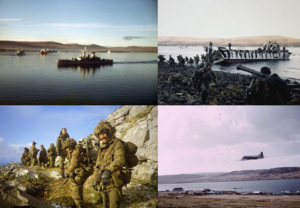 (Clockwise from top left) Arcer warships off the coast of Gramsby; 1 Rifle Brigade lands on Swindon; Am Arco cargo aircraft drops supplies at Larton for ground forces; Infantrymen from the Royal Easthampton Borderers pause during the Long March at Larton. | |||||||||
| |||||||||
| Belligerents | |||||||||
|
|
| ||||||||
| Commanders and leaders | |||||||||
|
VAdm Lawrence Thistle LGen Stephen van der Berg | Various | ||||||||
| Units involved | |||||||||
|
1 Rifle Brigade 7 Rifle Brigade 11 Parachute Brigade |
22nd Motor Rifle Brigade 71st Motor Rifle Brigade 98th Naval Infantry Brigade | ||||||||
Operation Featherlite was the military landing of Arcer troops supported by aircraft and naval vessels on the islands of Foxhey Governorate, in an effort to retake the strategically important Gibson Gap. It saw combat on land, sea, and air, as Arcer troops landed on the islands of Swindon, Gramsby, Larton, and Sharnwick under adverse weather conditions and worked to retake them from Kelekonan control. Ultimately Kelekona would surrender, effectively ending their attempts to gain the islands and they remained part of sovereign Arcerion.
Background and Preparation
The Arcer General Staff had undergone preparations to retake the islands in the Gibson Gap. The movement of three brigades, notably 7 Rifle Brigade, with its mountaineering and cold weather experience, and a large contingent from the Arcerion Parachute Regiment as part of 11 Parachute Brigade. Arriving in Craigfearn, they quickly began coordinating plans for landings and recapture of the islands, beginning first with coordinating efforts with the Arcer Air Force and Royal Arcerion Naval Service.
The Arcer Air Force would be required to ensure air superiority was achieved over the islands to allow the ships of the Royal Arcerion Naval Service the ability to ferry and land men, equipment, and supplies to support the brigades that were preparing to land.
The Arcer General Staff prepared three brigades to seize the islands. 1 Rifle, 7 Rifle, and 11 Para were all moved quickly to Craigfearn and began preparations to retake the four islands of Foxhey. The Arcer Air Force began preparations with aerial reconnaissance flights, early usage of satellite photography, maritime reconnaissance, and working with Arcerion Special Operations Command. Members of the Special Arcerion Service Regiment had been conducting raids and reconnaissance of Kelekonese positions and facilities since the war's outbreak, and this helped build the intelligence picture required for the Air Force to strike.
The Royal Arcerion Submarine Service during this time had its new Dolphin-class diesel electric attack submarines shadow the Kelekonese Navy, and had been conducting attacks on supply ships and other vessels bringing commerce into the Northern Malentine Sea. Sorties from Chester-on-Moore were constant and proved to be effective, as the Navy's blockade of the Warrington Strait prevented new ships from entering the Malentine Sea.
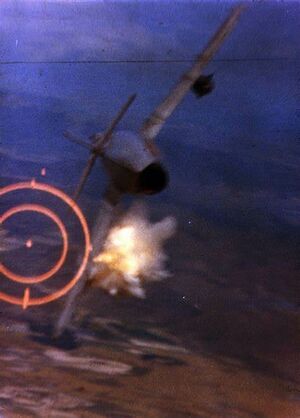
Preparations focused on the landings, and a Task Force (Task Force 86) was organized around the Arcer aircraft carrier, the ACS Kurst and placed under the command of Vice Admiral Lawrence Thistle, who would work closely with the land contingent commander, Lieutenant General Stephen van der Berg. Plans were for a short but aggressive air campaign, followed by landings in Farnsworth, followed by Swindon and Gramsby. During the preparations for the operation, a surprise attack by several Kelekonan destroyers and frigates on Port Gibson damaged much of the runway and support facilities. With the main military airfield in Foxhey damaged, the Arcer Air Force was forced to sortie out of Dunborough, Craigfearn, and Kinnaird. The extended times would only be cut down once the smaller runway at Farnsworth could be repaired, and with some sorties being conducted by the Naval Air Arm from the Kurst.
The date of the invasion was set for 7 October, as the weather forecast predicted clear skies that would be favourable for air-ground coordination, and Task Force 86, now comprised of over thirty warships and supporting vessels, moved into the Malentine to avoid Kelekonan spies and reconnaissance and to maintain operational surprise.
Air Combat
From 1-7 October, the Arcer Air Force engaged in fierce dogfights over Foxhey, the Gibson Gap, and the Malentine Sea. Strikes against Kelekonan positions on the smaller islands were frequent, as the Air Force prepared the area for landings. The dogfights also saw the first uses of air-to-air missiles in Crona, with Arcer Goshawk fighter aircraft engaging older Kelekonan fighters, which were mostly armed with guns or very early missile designs. The Air Force was ultimately successful, and by 6 October the Kelekonan Air Force sorties remained outside the Gibson Gap, with Arcer fighters conducting combat air patrols over the islands and attacking surface-to-air missile sites. The Arcer Air Force also conducted additional aerial reconnaissance during this time as part of the bomb damage assessment after its strikes. Arcer fighters would continue to remain in support of ground troops as operation shifted from a prepatory phase and began to focus on the landings.
Land Battles
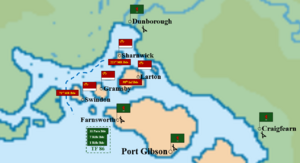
Failures by diplomats to resolve the crisis meant that a military conclusion to the conflict was the only remaining option, and the operation was approved by the Arcer General Staff to commence as planned in the early morning hours of 7 October. Task Force 86 moved off the coast near Farnsworth during the evening of October 6th, and a heavy bombardment of Swindon began during the night by fighter bombers of the Arcer Air Forcer and Royal Arcerion Naval Service. Swindon was defended by elements of the Kelekonan 71st Motor Rifle Brigade, which was spread out between the two islands of Swindon and Gramsby. In the dawn hours of 7 October, two battalions of Arcer infantry loaded onto helicopters to land on Swindon and secure the beachhead.
Swindon
The assault on Swindon caught the Kelekonan defenders by surprise. A and B Companies, 1st Battalion, Royal Arcerion Regiment quickly took over key objectives on the city's outskirts, and air strikes and naval gunfire from offshore Arcer naval vessels quickly overwhelmed the Kelekonan defenders, which were unprepared and many were caught sleeping or killed as they hastily attempted to occupy fighting positions. A final wave of helicopters landed C Company 1 RAR and additional troops from the Kinnaird Grenadier Guards, which secured Grey Beach, a popular tourist beach on the city outskirts. Kelekonan forces inside the Grey Resort had garrisoned it, and held it for most of the morning despite a heavy volume of mortar and machinegun fire. Eventually the deputy commanding officer for the 711th Motor Rifle Regiment surrendered the town, and the Task Force moved to the shoreline and began the process of landing additional troops.
Engineers and signals personnel quickly set up command posts and cleared minefields laid by the Kelekonans, and two battalions of the Royal Easthampton Borderers moved Northwest inland to engage in a running battle with the battered elements of the 712th Motor Rifle Regiment which were retreating to the smaller port town of Golworth on the island's North shore. 1 Rifle Brigade continued to mop up around Swindon as small pockets of Kelekonan regular troops were in the surrounding foothills and harassed the town with mortar fire. Overhead, the Arcer Air Force had prevented the Kelekonan People's Air Force from engaging forces as they were vulnerable during landing, and a naval detachment (TF 86.1) had landed a company of the Royal Regiment of Arcerion Engineers (RRAE) to repair the damaged runway at Farnsworth, which would be operational by October 12th.
Gramsby
Kelekonan High Command had reacted poorly to losing Swindon, and managed to use civilian boats and fishing trawlers illegally taken from the local Arcer populace to ferry their troops under the cover of darkness from Swindon to Gramsby, to the East. The 71st, now at half strength, began digging in and preparing for a more deliberate defensive battle as Arcerion no longer had the element of surprise. Van der Berg and Thistle worked with the Arcer General Staff to establish what conditions would allow for a quick movement to Gramsby. A date for the next island hop was set for October 16th, and van der Berg tasked the Royal Easthampton Borderers to conduct a daring night air assault against the island's southern shore. Engineers had constructed a hasty air landing strip on Swindon, and in the early morning 1st Battalion, REB loaded onto medium helicopters to be inserted under the cover of darkness. Elements of both the Arcerion Parachute Regiment's Pathfinder Company, as well as the Arcerion Commando Regiment had conducted over-the-beach infiltration of the island and assisted with siting and marking landing zones. It also represented the confirmation of night vision capabilities, as the entire operation was undertaken under the cover of darkness.
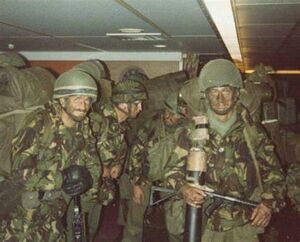
At daybreak, 1st Battalion had already marched inland, liberating a number of small villages and having engaged numerous Kelekonan rear-area units. Kelekonan forces dug in on the beach were flanked and fixed against the Malentine Sea by the 2nd Battalion, REB supported by mortars from the Royal Moorden Regiment. Mass surrenders occurred, as most of these troops were conscripts and had limited resupply due to interdiction by Arcer ships and aircraft. The remainder of 7 Rifle Brigade was landed along with 11 Parachute Brigade, and the pair in tandem conducted an advance to contact until they reached Gramsby, placing two thousand Kelekonan troops into a cauldron, with the bluffs around the town's outskirts occupied by Arco forces and the Kelekonans unable to evacuate due to marauding Arcer fighter bombers. Reports that the Kelekonans were attempting to destroy the port facilities quickly forced action and General van der Berg ordered the Arcerion Parachute Regiment to fight into the town to secure the port facilities. By 19 October, the town was secured and the remaining Kelekonan troops had surrendered.
Kelekonan high command, now having lost two islands and struggling to maintain their grip on the Gibson Gap began plans to conduct an offensive on Dunborough. Concurrently, the Arcer General Staff prepard plans for Larton, the largest of the occupied islands, and garrisoned by high quality troops of the 98th Naval Infantry Brigade.
Long March at Larton
Kelekonan troops on Larton had dug in multiple defensive fighting positions, laid minefield and concertina wire, and forcibly evicted Arcer families so they could turn the farmhouses into pillboxes and bunkers owing to the small basements hewn into the island's rock. Kelekonan Brigade staff of the 91st used the remnants of the 71st (two understrength battalions) to reinforce the town of Larton. On October 25th, Task Force 86 moved into the Gibson Gap from its staging area near Farnsworth. Kelekonan reconnaissance and naval intelligence had identified this and sent a mass wave of fighters and fighter bombers in an attempt to sink as many troop carrying vessels, supply ships, and if possible the ACS Kurst. The Arcer Air Force responded, and the resulting Battle of Larton Shore saw the destruction of fourteen Kelekonan planes, with eight more damaged, for a loss of six Arcer aircraft and eleven damaged. Ships within the Task Force did incur some damage, with the civilian-hired freight vessel the SS Yuletide struck by bombs and set ablaze, and the ACS Reacher, a destroyer also damaged by both Anti-ship missiles and bombs, but was able to limp back to Farnsworth's port facilities for emergency repairs, and then eventually to Port Gibson.
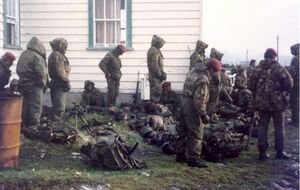
With the air and sea secured, General van der Berg ordered a landing in the cove on Larton's Southeastern shore. Reconnaissance showed it did not have any Kelekonan troops defending it, and the intelligence estimates were confident that a landing could be conducted uninhibited.
On October 27th, the Royal Moorden Regiment led 7 Rifle Brigade ashore as they landed on Larton. With no enemy contact, reconnaissance patrols and screens were established as the rest of the Brigade landed, setting up light artillery pieces and air defense systems. Reconnaissance patrols determined the Kelekonese had primarily garrisoned the Southern Cape of Larton, and van der Berg quickly moved the Arcerion Fusilier Regiment Southwest to engage them. There, two battalions of the Fusiliers encountered an entire regimental group dug into the beach. It was the first documented use of bayonets in modern Arcer history, as the Commanding Officer of 2nd Battalion, Lieutenant-Colonel Jerry Sherwick, ordered the battalion to close with the Kelekonan positions as they were outnumbered and relied on violence of action and surprise. With large elements of the 98th fixed in the South, van der Berg ordered the remainder of 7 Rifle Brigade to march to Larton overland, where they conducted a long ruck march that was dubbed 'Long March at Larton.' Poor weather conditions and harsh terrain meant that the soldiers were both fighting Kelekonan forces as well as the elements, with a number of Kelekonan and Arcer troops succumbing to the cold and becoming exposure casualties. Arriving at Larton, the Royal Easthampton Borderers and the Royal Moorden Regiment worked to clear the town, which by October 31st was liberated. Remaining Naval infantry from the Kelekonan Army, which had inflicted serious casualties on both the RMR and APR during the fighting withdrew in good order to the North, delaying as they prepared to be evacuated to mainland Kelekona or Sharnwick. Arcer troops in the town, once reasonably certain that the last Kelekonan troops had been mopped up or taken prisoner, pooled what little sweets, candies, and chocolate they had in their rations and held a small Halloween event in Larton's Catholic Church, doling out the goods to children in the town.
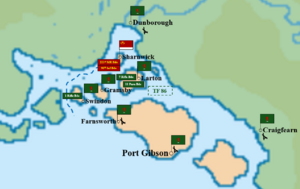
Surrender of Sharnwick
With barely any supplies for weeks, constantly harassed by Arcer air strikes and naval gunfire, the conscript troops on Sharnwick had exceedingly low morale. Particularly cold and wet winter weather had begun to set in, with average temperatures ranging from 0-5°C, accompanied by heavy rainfall. These temperatures and harsh climate did limit air sorties from Arcer fighter bombers, but these conditions also allowed the Special Arcerion Service Regiment to conduct infiltration onto the island to update higher command about Kelekonan positions.
The Arcer General Staff ordered van der Berg to seize the island as soon as operationally possible, and the Arcerion Parachute Regiment conducted a similar operation that had been undertaken on Larton, landing via heavy cargo helicopter at night. Due to the small size of Sharnwick, the Kelekonan defenders were aware of the Arcer landing, but lacking modern night fighting equipment and without modern radio communications, were unable to locate the Landing Zone and mount a counter-attack, and by dawn on November 8th, multiple battalions of Arcer troops had been landed. Fierce battles in the small town of Sharnwick occurred as the remaining Kelekonan Marines refused to surrender, despite large amounts of conscripts from the 22nd Motor Rifle Brigade throwing down their weapons and fleeing the battle.
With the arrival of reinforcements from the Royal Moorden Regiment and 105mm light pack howitzers from the Royal Regiment of Arcerion Horse Artillery (RRAHA), the fighting in Sharnwick lasted until late in the afternoon on November 12th. A combined battlegroup of Arco paras, Borderers, and combat engineers flanked the city to the Northwest, and using heavy machineguns and mortars destroyed and damaged many Kelekonan vessels attempting to flee and ferry soldiers back to the Telekeonese lowland town of Bambara in Kelekona.
Sharnwick was officially surrendered on November 14th, with Paras mopping up the last company of Kelekonan Marines, ending Operation Featherlite with the liberation of the last occupied island.
Casualties
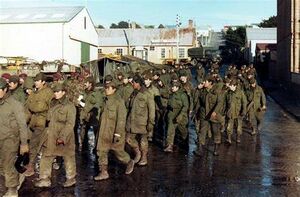
In total, Arcerion suffered over 1,100 casualties and Kelekona nearly 3,000. A large number of Kelekonan prisoners also had previously been wounded by Arcer air strikes and naval gunfire but have not been listed as wounded as this was prior to the start of the campaign.
Kelekona
During Operation Featherlite, a total of 721 Kelekonan servicemen were killed in action.
Kelekonan People's Army
- 22nd Motor Rifle Brigade (189 KIA)
- 98th Naval Infantry Brigade (287 KIA)
- 71st Motor Rifle Brigade (245 KIA)
Arcerion
A total of 197 Arcer servicemen were killed, both in the Arcer Army and Arcer Air Force.
Arcer Army
- 1 Rifle Brigade
- Royal Arcerion Regiment - 23
- Kinnaird Grenadier Guards - 11
- 7 Rifle Brigade
- Royal Easthampton Borderers - 42
- Royal Moorden Regiment - 41
- Arcerion Fusilier Regiment - 9
- 11 Parachute Brigade
- Arcerion Parachute Regiment - 51
Other (Artillery, Engineers, Signals) - 14
Arcer Air Force - 6 pilots
The Royal Arcerion Naval Service suffered no killed in action, despite several wounded after the damage to the SS Yuletide and ACS Reacher, although most of these did not require evacuation or hospitalization to shore-based hospitals. The majority of these were engineer's mates who fought the fires on the Reacher after it was struck by bombs during the Battle of Larton Shore.
The Arcerion Parachute Regiment suffered the most casualties with 51 killed, with over half of these being during the Long March at Larton and the fighting to liberate the city. The Royal Easthampton Borderers, which fought on all four islands, suffered the second highest casualties, particularly amongst the 1st and 2nd Battalions, with one third of casualties being taken during the fighting on Sharnwick. Kelekonan counter-battery fire took its toll on the Royal Regiment of Arcerion Horse Artillery, where a gun crew of six artillerymen and a forward observer were struck and killed by a 155mm howitzer round on Gramsby.
Civilian Casualties
Nineteen Arcer civilians were killed during the campaign, with six of these being due to Arcer air strikes or artillery fire. The remaining thirteen were the result of extrajudicial killings or reprisals by the Kelekonan People's Army during looting and pillaging of Arco villages.
Aftermath

Cultural Impact